Introduction
These are new puzzles that aren’t finished yet. You can try them out and let me know what you think.
Table of Contents
- Donimo Drivers is a puzzle I designed where dice can walk over the dominoes or drive them around. (1 player, 4 dice, and double-six dominoes)
- Adding Donimoes is a puzzle I designed where you add dominoes in the given order. (1 player, double-six dominoes)
- Khufu is a trick-taking game, inspired by David Parlett’s card game, 99. (2-3 players, double-six dominoes)
- Tetromino Road is a board game I designed where you lay out dominoes with roads between them. (2 players, double-six dominoes, beads and coins)
- Writing Rules is a section to help me remember how to create the different types of diagrams.
- Solutions
Puzzles
Donimo Drivers
Dice can walk or drive to their destination.
Goal
Get all the blank squares into one connected group. Diagonal connections don’t count.
Start
Arrange the dominoes in the problem’s starting position. Then place a die on each of the corners, so its top face matches the number it’s on.
Moves
Each die can do one of three things on each turn:
- Walk on a number smaller than its own.
- Drive a domino while sitting on a matching number.
- Rest on a matching number while another die moves.
There are several limits to the moves. Only one die can move at a time, so the other three must be resting on their own numbers. Once a die starts walking, it must continue until it rests on its own number again. A die can only walk onto an empty, neighbouring number, and diagonal neighbours don’t count. A domino can only be driven when it has a die on it, and driven along its longer direction, not sideways. It moves one space at a time, and all the dominoes must be in one connected group before and after each move. Again, diagonal connections don’t count.
Problems
Here are the starting positions for several Donimo Drivers problems. The solutions are listed at the end.
Problem 1

Problem 1b

Problem 1c

Problem 1d

Problem 1e

Problem 2
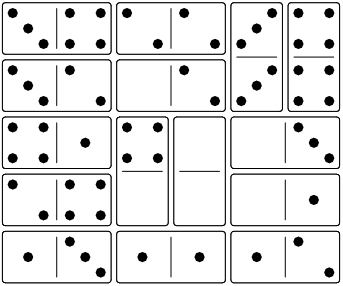
Problem 3
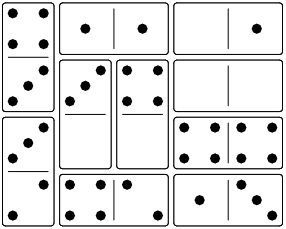
Problem 4
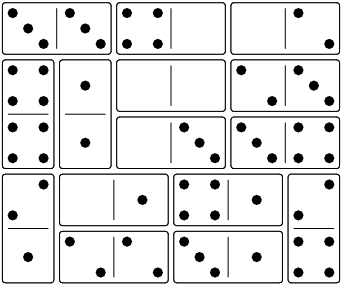
Adding Donimoes
The idea was to avoid the slow setup phase at the start of the other puzzles.
Goal
The goal is to add all the dominoes from the queue onto the board. Each problem shows the queue of dominoes to add, from left to right.
Start
Take the two dominoes from the left end of the queue and place them on the board in the same position relative to each other.
For example, if this is the queue:
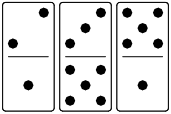
Then the start position is like this:
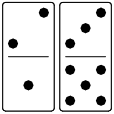
Not like this:
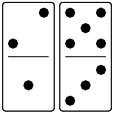
Moves
There are only two ways a domino can move.
Adding
The next domino from the queue can be added to the board if it matches at least two of the adjacent numbers on neighbouring dominoes. Those two adjacent numbers can match the two ends of the domino, or both match one end.
In this example, the 13 can be added, because it matches the 1 below and the 3 below.
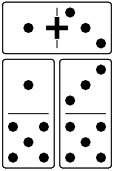
In this example, the 52 can be added, because it matches the 5 beside and the 5 above. The 52 could also be added in the vertical position.

Sliding
Move a domino one space along its long axis so that it ends up with at least one of its numbers next to an adjacent number that adds up to six, or it matches at least two of the adjacent numbers on neighbouring dominoes.
In this example, the left domino can move down, because the 1 and the 5 add to six.
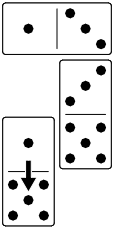
The left domino can move back up, because the 1 matches the 1 above, and the 5 matches the 5 to the right.
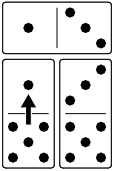
Stay Connected
All the dominoes on the board must stay in one connected group, you can’t split the group after moving a domino.
Problems
Here are the starting positions for several Adding Donimoes problems. The solutions are listed at the end.
Problem 1

Games
Khufu
I spent a lot of my childhood playing Oh Hell, so I loved David Parlett’s 99 when I read his book, “Original Card Games”. Building your bid out of three cards from your hand adds a lovely puzzle to the beginning of each hand.
In this game, I tried to capture some of that bidding puzzle and also take advantage of the dominoes’ flexibility. You can choose whether to use the big number or the small number of each domino as its suit. Since David Parlett said he preferred the name Sphinx for his game, I called this Khufu - the Sphinx’s neighbour.
New players should play a round without any bidding, then add bidding for tricks, then add bidding for big or small suits.
Setup
Shuffle the dominoes face down, then each player flips over one domino. Highest total pips will lead the first trick. Players tied for the lead should flip over another domino to break the tie.
Starting the Hand
At the beginning of each hand, shuffle the dominoes face down, then the leader flips one domino face up to choose the trump suit. Leave it face up in front of the leader. Each player now draws nine dominoes and looks at them without letting the other players see.
Normally, the players bid points to choose big or small suits, then use two dominoes to place a secret bid for tricks. If there are new players, however, skip the bidding, play with big suits, and only draw seven dominoes. Bidding will be explained at the end.
Taking Tricks
Every domino played will use one of its numbers as a suit and the other as a value. If suits are big, then the bigger number is the suit. If suits are small, the smaller number is the suit. The other number is the value in the suit. The same rule applies to the domino turned up for trump.
Starting with the lead, each player plays one domino face up to the middle of the table. If they have any dominoes in the led suit, then they have to play one of them. If not, they can play any domino, trump or not. If any trumps are played, the one with the biggest value wins the trick. Otherwise, the domino with the biggest value in the led suit wins the trick. Remember, even when suits are small, the biggest value still wins the trick.
Whoever wins the trick places the dominoes in a face-down stack to the left of their hand, and then leads to the next trick.
Example 1: Alice leads 41 when the trump is 32 and the suits are big. Bob plays 43 to beat Alice in the 4s suit, but Charlie has no 4s and wins by playing 31, a trump.
Example 2: Alice leads 41 when the trump is 32 and the suits are small. Bob has no 1s and plays 43, a trump. Charlie has to play 31, his only domino in the 1s suit. Although Alice has the highest of the 1s, Bob wins with the trump.
Bidding for Suits
Players bid in turn, starting with the player to the left of the lead. Each bid is either “big” or “small”, followed by a number, or a player may pass. The first bid may not pass, but it may be zero. Every bid after that must be at least one higher than the previous bid or a pass. Players may bid in later rounds after they pass. When all players pass, the final bid decides whether each domino uses its big number or its small number as a suit. The value of the bid gets added to the scores of all the players except the one who made the bid.
Bidding for Tricks
Each player chooses two dominoes from their hand, and places them face down to the right of their hand. These two dominoes secretly record how many tricks the player thinks they will win. The two dominoes in the bid use their smaller number as the value of the bid, so 62 and 33 would form a bid for five tricks. Even when suits are big, bidding for tricks always uses the smaller number.
After all players have placed a bid, players may convert their bid to “declare” or “reveal”. Declaring is flipping your bid face up, and revealing is showing your hand as well as your bid. To be formal, go around the table from the lead’s left, allowing players to make premium bids, with “reveal” surpassing “declare”. Only one player may make a premium bid.
Scoring
After playing all seven tricks in a hand, players reveal their bids and record the scores. Winning each trick scores one point, but the big points come from matching the bid. Look at how many players matched, then score 10 points if all three matched, 20 points if two matched, and 30 points if only one matched. A “declare” bid wins an extra 30 points, and a “reveal” bid wins an extra 60, making 97 a perfect score.
A game is played to 100 points. Leading the first trick passes to the left.
Two-Player Variant
Deal a dummy hand face down, and pick two random dominoes as its bid. After all the bidding is finished, flip the dummy hand face up and leave its bid face down.
The lead player for each trick always plays the third domino to the trick from the dummy hand. If the dummy wins a trick, the player who led the previous trick leads from the dummy hand and plays third from their own hand.
Scoring works as normal, counting the dummy as a third player.
Tetromino Road
The dominoes are played on an 8x8 grid. Make the edges out of face-down dominoes, or play on a chess board where a pair of squares are the same size as one of your dominoes.
Choose which player will play the tetrominoes dark side up, and give them 3 dark player tokens. Give the other player 3 light player tokens. Each player draws 3 dominoes and keeps them hidden from their opponent.
On your turn, you must place a domino and then mark any spaces that must be roads. At any time during your turn, you may play a token or tetrominoes.
Placing Dominoes and Tokens
Dominoes and tokens must be played on empty spaces so that they touch the edge of the board or another item that’s already on the board. Diagonal connections don’t count as touching.
Placing Roads
If a number on a domino is completely surrounded by other numbers, the surrounding numbers must exactly equal 3 times the number of neighbours. Corners must have neighbours equal to 6, sides must equal 9, and centre spaces must equal 12. If a square has only one empty space next to it and it would be impossible to fill that space with a legal number, then that space must be a road. After placing a domino, check to see if any spaces must be roads and place road markers on them.
At the end of the game, all road spaces on the board must form one connected road network, so you can also place road markers where they are needed to keep the roads connected.
If an empty space has no empty spaces next to it, then no dominoes will fit on it. Place a road marker on it.
If a player token is on a space that must be a road, replace it with a road marker and give it back to the player. However, check to see whether the player can use it to play a tetromino before replacing it. The active player can choose what order to play road markers.
Placing Tetrominoes
Tetrominoes need to be played on spaces with either road markers or player tokens. They cannot be played on spaces with dominoes, other tetrominoes, or empty spaces. At least one of the spaces must have a player token that belongs to the player who’s playing the tetromino.
If a player’s token is getting replaced during their opponent’s turn, they may use it immediately to place a tetromino. The opponent then continues their turn if they have more road markers to place. (Should the player’s turn end when they have to replace another player’s token?)
Tetrominoes can’t be moved after they are played, and they must be played with the player’s side up. If a player’s token is getting replaced and there aren’t any tetrominoes that will fit, the token is just returned to the player.
Winning
The player who plays 4 tetrominoes wins.
Software Tips
Writing Rules
Here are some examples of the diagrams that you can draw using code blocks:
Basic dominoes are shown as numbers joined by the | or - characters. Leave spaces between the numbers that aren’t joined.
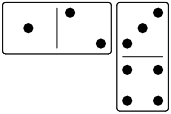
You can mix unjoined cells from Dominosa in with regular dominoes.
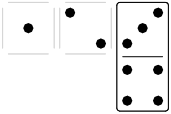
Usually, the dominoes are all lined up with each other, but you can offset them by half a space.
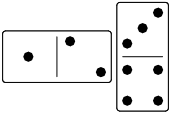
You can draw arrows to mark a moved domino with <^v> characters in the middle of it, mark an added domino with a +, or a removed domino with a *.
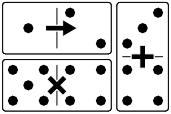
There are several things you can draw on top of the dominoes by adding an extra section. You can add letter markers on top of the dominoes, and list the number under each marker.
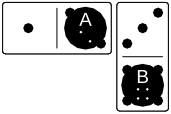
If your markers aren’t unique, list them with their positions.

There are two special markers: lower-case b and w for black and white markers.

You can add dice by giving the coordinates and the value on top.
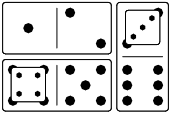
You can add arrows by giving the start coordinates and the directions to move.

You can combine the different types of extras into the same diagram. Order of the sections doesn’t matter, but order of the arrows matters if they overlap.
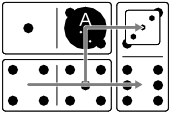
Dominosa
Dominosa boards can include a partial solution, but one of the headings must be “Dominosa”.
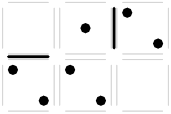
Solutions
Donimo Drivers Solutions
The walking moves are described with the number of a die, a direction, and a distance. For example, 1R3 means move the 1 die to the right, 3 spaces. A move with no distance means one space. The driving moves have a small letter ‘d’ for ‘domino’ after the die number, like 1dR.
- 3dR, 4dL, 1L, 1U, 1dU
- 3D, 3R4, 3dU, 4dU, 2L2, 2U3, 2dR
- 1L2, 2dD, 3L2, 3U, 3L, 3U, 4dD, 1dL2, 3dU, 4R2, 4dU
- 4dD, 4U, 4L2, 4U, 4dR, 4U3, 4L2, 2dR, 4dR, 3dR, 4D, 4L3, 4dU, 1dU, 1R2, 2L2, 2D, 2L3, 2D, 2L, 2dD, 2R, 2U2, 2R3, 2U, 2R2, 4dD, 4R3, 4U, 3dL, 4dL, 2dL, 1dR
Adding Donimoes Solutions
Here are the solutions to the Adding Donimoes problems. For each step, move the listed domino left, right, up, or down. Adding moves contain the domino numbers, (H)orizontal or (V)ertical direction, and the position to place it. The top left corner is 11, one space to the right is 21, and one space below is 12.
- 36D, 23V21, 33D, 53V32, 25H21, 36D, 23D, 22H13, 33D, 53D, 22R
Donimoes is an original puzzle designed by Don Kirkby.
